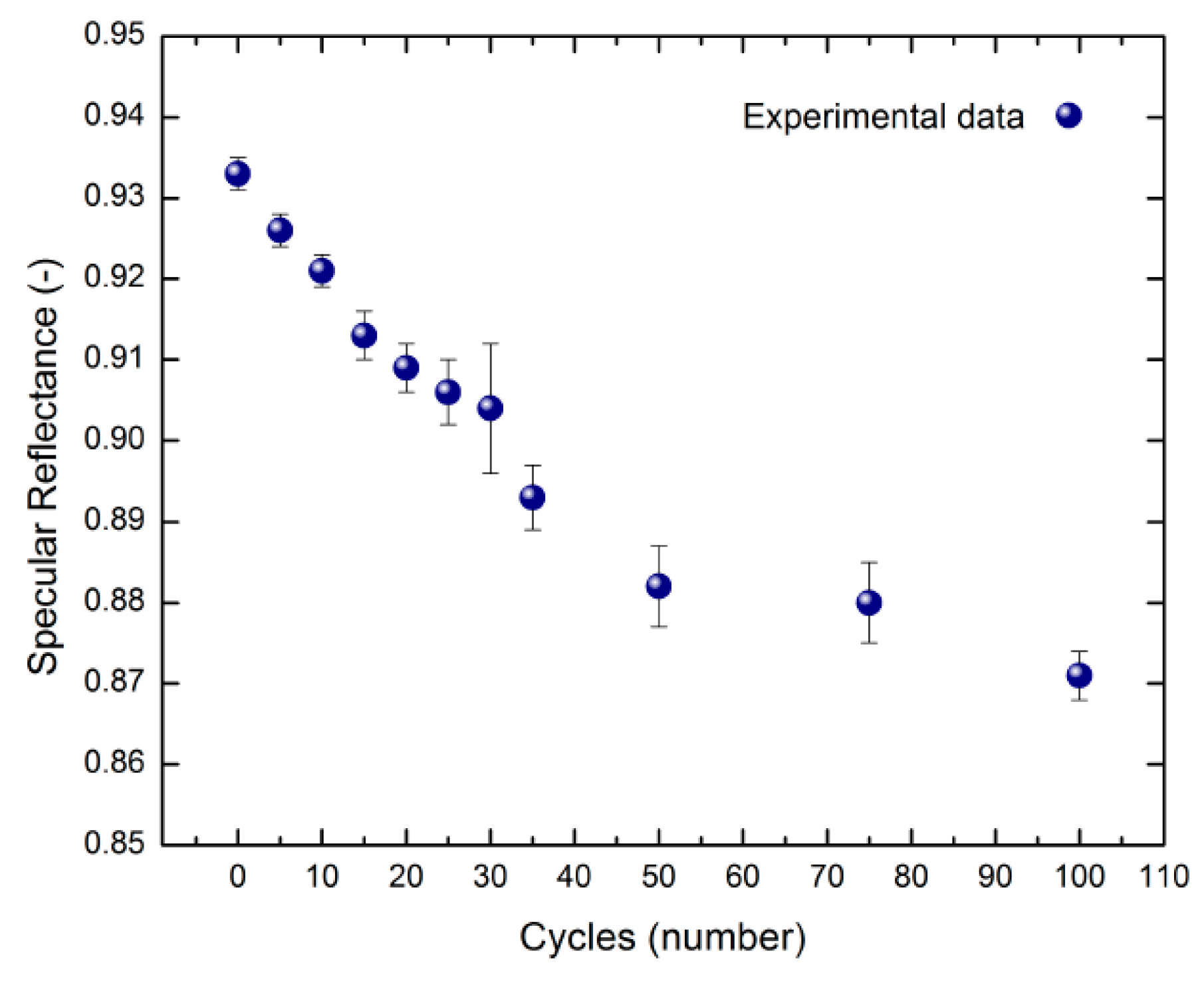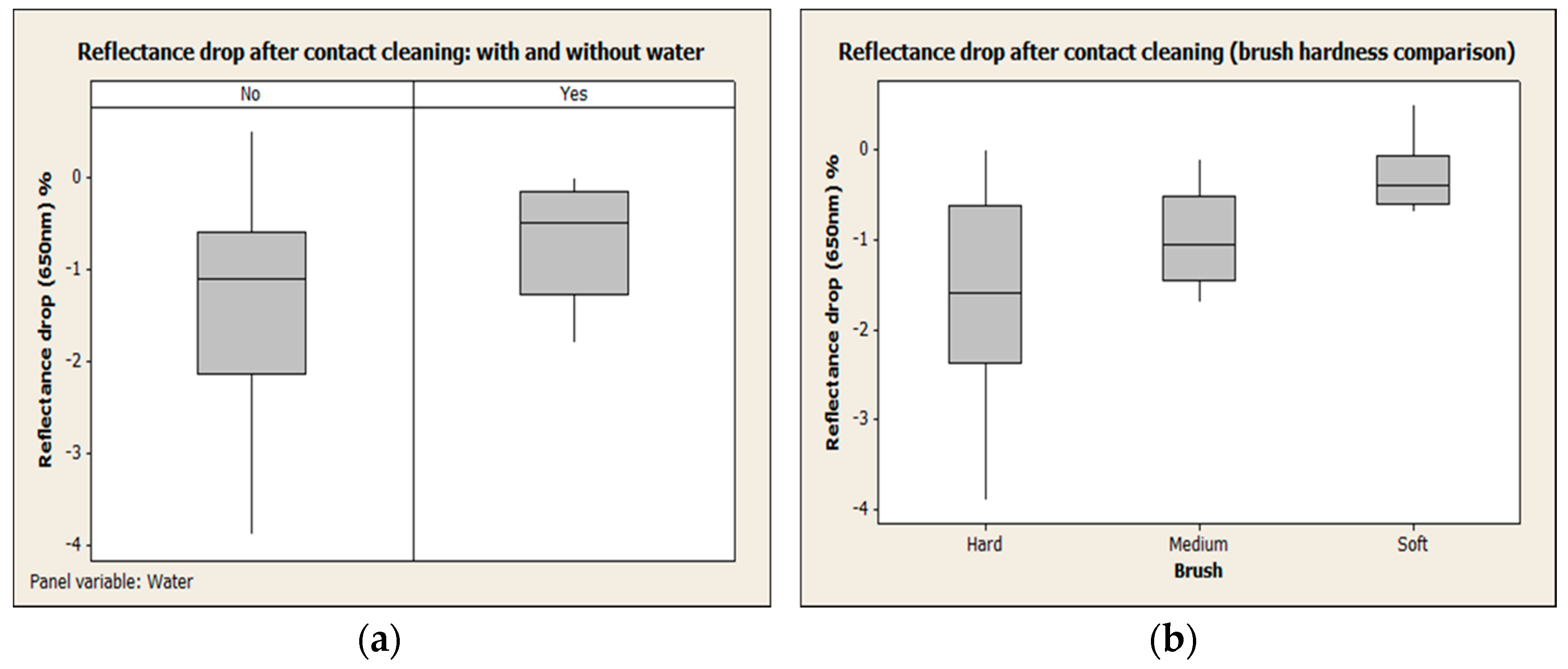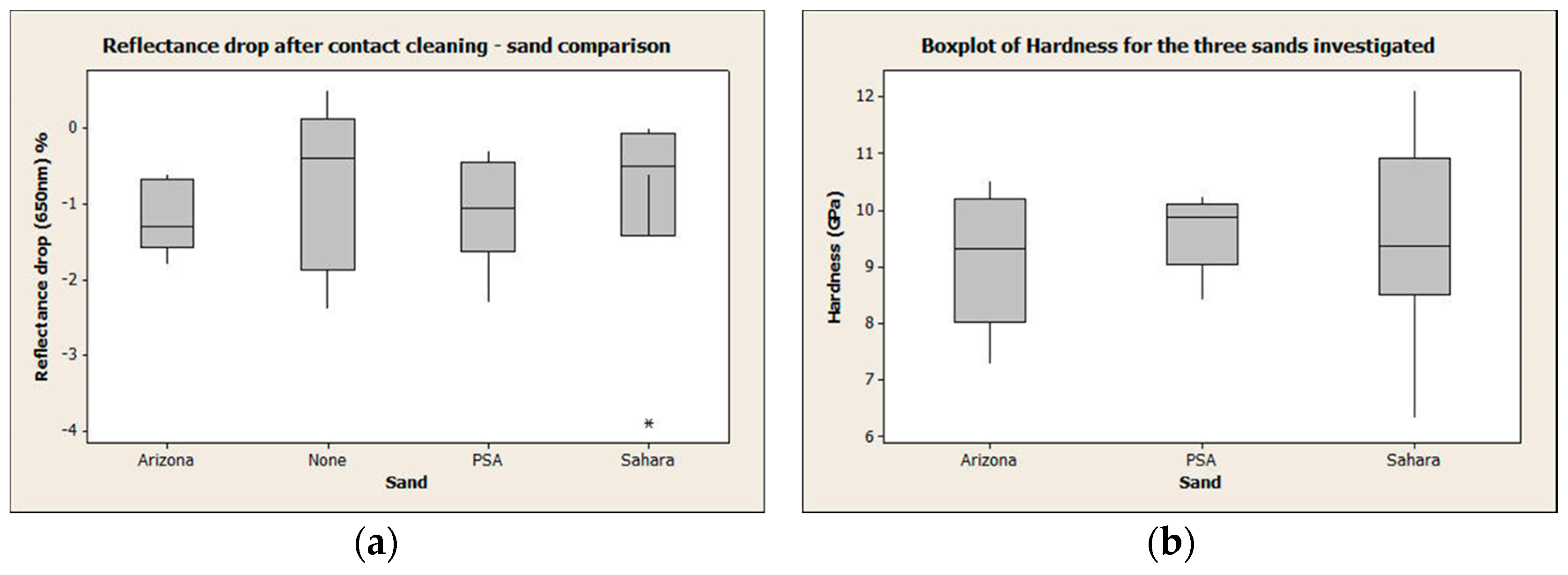Soiling and Cleaning of Polymer Film Solar Reflectors
Abstract
:1. Introduction
2. Methods and Materials
2.1. The Effect of Existing Contact Cleaning Methods
2.2. New Benign Contact Cleaning Regime
2.2.1. Sample Preparation
2.2.2. Contact Cleaning Experimental Set-Up
3. Results and Discussion
3.1. Cranfield University Experimental Results
3.2. PSA Experimental Results
- As with all solar collectors, soiling must be periodically removed from collector surfaces.
- For silvered polymer film collectors, brush-and-water contact cleaning is highly effective in removing soiling, but has been shown to damage the film.
- This work shows that a soft brush with water is an effective method to remove soiling without damaging the surface of the film.
- Cleaning is most effective with both a lateral and rotational movement of the brush.
- The soft brush with water regime was effective in removing all three sand types considered.
- The results were validated by carrying out the soiling trials in two locations with different experimental apparatuses and different analytical tools.
- Silvered polymer film solar reflectors can reduce the cost of solar heating and cooling in sustainable communities of the future.
4. Conclusions
Acknowledgments
Author Contributions
Conflicts of Interest
Abbreviations
| CSP | Concentrated solar power |
| PSA | Plataforma Solar de Almería |
| D&S | Devices and Services |
| SFEG | Schottky Field Emission Gun |
| ESEM | Environmental Scanning Electron Microscope |
| MIL-STD | United States Military Standard |
References
- Lenzen, M. Current state of development of electricity-generating technologies: A literature review. Energies 2010, 3, 462–591. [Google Scholar] [CrossRef]
- Calise, F.; Vanoli, L. Parabolic trough photovoltaic/thermal collectors: Design and simulation model. Energies 2012, 5, 4186–4208. [Google Scholar] [CrossRef]
- Manzano-Agugliaro, F.; Alcayde, A.; Montoya, F.G.; Zapata-Sierra, A.; Gil, C. Scientific production of renewable energies worldwide: An overview. Renew. Sustain. Energy Rev. 2013, 18, 134–177. [Google Scholar] [CrossRef]
- Corona, B.; Ruiz, D.; San Miguel, G. Life cycle assessment of a HYSOL concentrated solar power plant: Analyzing the effect of geographic location. Energies 2016, 9. [Google Scholar] [CrossRef] [Green Version]
- Fernández-García, A.; Rojas, E.; Pérez, M.; Silva, R.; Hernández-Escobedo, Q.; Manzano-Agugliaro, F. A parabolic-trough collector for cleaner industrial process heat. J. Clean. Prod. 2015, 89, 272–285. [Google Scholar] [CrossRef]
- García-Segura, A.; Fernández-García, A.; Ariza, M.J.; Valenzuela, L.; Sutter, F. Durability studies of solar reflectors: A review. Renew. Sustain. Energy Rev. 2016, 62, 453–467. [Google Scholar] [CrossRef]
- DiGrazia, M.; Gee, R.; Jorgensen, G. ReflecTech mirror film attributes and durability for CSP application. In Proceedings of the 5th International Conference on Energy Sustainability, San Francisco, CA, USA, 19–23 July 2009; ASME: New York, NY, USA.
- Fernández-García, A.; Álvarez-Rodrigo, L.; Martínez-Arcos, L.; Aguiar, R.; Márquez-Payés, J.M. Study of different cleaning methods for solar reflectors used in CSP plants. Energy Procedia 2014, 49, 80–89. [Google Scholar] [CrossRef]
- Macerol, N. Polymer Film versus Glass Collectors for Concentrated Solar Power. Master’s Thesis, Cranfield University, Cranfield, UK, 2012. [Google Scholar]
- Sansom, C.; Fernández-García, A.; Sutter, F.; Almond, H.; King, P. Contact cleaning of polymer film solar reflectors. In Proceedings of the International Conference on concentrating Solar Power and Chemical Energy Systems (SolarPACES), Cape Town, South Africa, 13–16 October 2015.
- ISO 11998: Paints and Varnishes—Determination of Wet-Scrub Resistance and Cleanability of Coatings; International Organization for Standardization (ISO): Geneva, Switzerland, 2006.
- ASTM D2486: Standard Test Method for Scrub Resistance of Wall Paints; American Society for Testing and Materials (ASTM): West Conshohocken, PA, USA, 2012.
- Fernández-García, A.; Martínez-Arcos, L.; García-Segura, A. Abrasion Test Results of a Polymer Film Solar Reflector; Tech Report OPAC-AA_20141124_polymer_abrasion; PSA: Almería, Spain, 2014. [Google Scholar]
- Sansom, C.; Comley, P.; King, P.; Almond, H.; Endaya, E. Predicting the effects of sand erosion on collector surfaces in CSP plants. Energy Procedia 2015, 69, 198–207. [Google Scholar] [CrossRef]
- Pettit, R.B. Characterizing Solar Mirror Materials Using Portable Reflectometers; Tech Report SAND82–1714; Sandia National Laboratories: Albuquerque, NM, USA, 1982. [Google Scholar]















| Sand Type | C | O | Na | Mg | Al | Si | Cl | K | Ca | Ti | Fe | Total |
|---|---|---|---|---|---|---|---|---|---|---|---|---|
| Atomic % (SFEG) | ||||||||||||
| Sahara | - | 65.56 | 0.55 | 2.16 | 5.46 | 22.57 | 0.59 | 1.16 | 0.29 | 0.09 | 1.57 | 100 |
| Sahara | - | 62.86 | 0.41 | 1.49 | 6.81 | 24.36 | 0.53 | 2.01 | 0.38 | 1.15 | 100 | |
| Sahara | - | 65.54 | 0.74 | 2.74 | 7.95 | 17.44 | 0.81 | 1.63 | 1.31 | 0.14 | 1.69 | 100 |
| Sahara | - | 76.61 | 0.45 | 1.63 | 3.5 | 6.04 | 0.37 | 0.55 | 9.84 | - | 1.02 | 100 |
| Sahara | - | 69.23 | - | 1.22 | 2.48 | 5.69 | 0.39 | 0.44 | 19.77 | - | 0.77 | 100 |
| Sahara | - | 65.65 | - | 1.07 | 4.08 | 26.82 | 0.39 | 1.06 | 0.26 | - | 0.68 | 100 |
| Arizona | 10.41 | 63.68 | - | 2.8 | 11.08 | 5.58 | - | - | 4.18 | - | 2.27 | 100 |
| Arizona | 6.92 | 56.66 | - | 0.8 | 16.13 | 14.32 | - | - | 1.58 | - | 3.59 | 100 |
| Arizona | 5.98 | 64.64 | - | 0.86 | 9.04 | 17.28 | - | - | 1.18 | - | 1.02 | 100 |
| Arizona | 6.39 | 62.28 | - | 0.84 | 13.72 | 13.5 | - | - | 1 | - | 2.28 | 100 |
| Arizona | 4.4 | 64.33 | - | 0.3 | 12.28 | 16.08 | - | - | 0.44 | - | 2.18 | 100 |
| Arizona | 5.45 | 66.9 | - | 0.23 | 5.6 | 21.17 | - | - | 0.21 | - | 0.45 | 100 |
| PSA | 0 | 58.34 | 0.54 | 0.53 | 8.79 | 26.01 | 0.36 | 2.01 | 1.43 | - | 1.98 | 100 |
| PSA | - | 63.93 | 3.75 | 0.55 | 14.35 | 14.9 | 0.17 | 0.6 | 0.25 | - | 1.5 | 100 |
| PSA | - | 49.32 | - | - | 14.93 | 21.9 | 0.67 | 10.64 | - | 2.54 | 100 | |
| PSA | - | 46.54 | 0.91 | 0.76 | 18.32 | 21.82 | - | 5.67 | 1.24 | - | 4.74 | 100 |
| PSA | - | 59.18 | - | 0.97 | 12.47 | 19.83 | 0.47 | 3.24 | 0.59 | - | 3.26 | 100 |
| MIL-STD silica | - | 64.41 | - | - | 0.93 | 34.18 | - | - | - | - | 0.48 | 100 |
| MIL-STD silica | - | 67.81 | - | - | 1.35 | 30.84 | - | - | - | - | - | 100 |
| MIL-STD silica | 7.09 | 59.5 | - | - | 0.33 | 32.92 | 0.16 | - | - | - | - | 100 |
| MIL-STD silica | - | 70.71 | - | - | 5.62 | 19.23 | 0.11 | 4.14 | - | - | 0.2 | 100 |
| MIL-STD silica | - | 66.92 | - | - | 0.19 | 32.62 | 0.16 | - | - | - | - | 100 |
| MIL-STD silica | - | 63.34 | - | - | 0.31 | 36.2 | 0.14 | - | - | - | - | 100 |
© 2016 by the authors; licensee MDPI, Basel, Switzerland. This article is an open access article distributed under the terms and conditions of the Creative Commons Attribution (CC-BY) license (http://creativecommons.org/licenses/by/4.0/).
Share and Cite
Sansom, C.; Fernández-García, A.; Sutter, F.; Almond, H.; King, P.; Martínez-Arcos, L. Soiling and Cleaning of Polymer Film Solar Reflectors. Energies 2016, 9, 1006. https://doi.org/10.3390/en9121006
Sansom C, Fernández-García A, Sutter F, Almond H, King P, Martínez-Arcos L. Soiling and Cleaning of Polymer Film Solar Reflectors. Energies. 2016; 9(12):1006. https://doi.org/10.3390/en9121006
Chicago/Turabian StyleSansom, Christopher, Aránzazu Fernández-García, Florian Sutter, Heather Almond, Peter King, and Lucía Martínez-Arcos. 2016. "Soiling and Cleaning of Polymer Film Solar Reflectors" Energies 9, no. 12: 1006. https://doi.org/10.3390/en9121006






